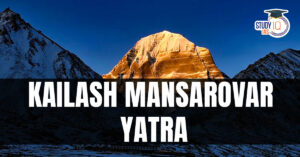Current Affairs 7th April 2023 for UPSC Prelims Exam
Bhagwan Mahavira
Context: Mahavira Jayanti, the birthday of the founder of Jainism, was celebrated across the country by Jain Community.
About Mahavira:
- Mahavira is the 24th and the last Tirthankara, who preached the essence of life, virtue and non-violence towards all living beings.
- Date: According to the Swetambaras, he was born in 599 BC but Digambar school of Jainism believe that Mahavira was born in 615 BC.
- Birth: Lord Mahavira, also referred to as Indian sage Vardhamana, was born in Kundalagrama, Bihar, as a son to king Siddartha and Queen Trishala.
- Renunciation: At the age of 30, he renounced his throne and other worldly possessions, and spent twelve years of his life as ascetic.
- He led an austere life for 12 years before attaining ‘Kevala Jnana’ or omniscience.
- Nirvana: At the age of 72, he attained nirvana, and devoted the rest of his life to preach spiritual freedom.
Teachings of Mahavira
- Mahavira gave highest respect to all living beings and preached non-violence.
- He set an exemplary control over his senses which later earned him the name Mahavira.
- Mahavira believed in a preached ahimsa or non-violence, satya (truth), asteya (non-stealing), brahmacharya (chastity) and aparigraha (non-attachment).
- It was his main disciple Indrabhuti Gautama who had put together his teachings and provided a source of information and learning for all.
- Places associated with his life: Kalpa Sutra states that Mahavira lived in Astikagrama, Prastichampa, Nalanda, Mithila, Bhadrika, Vaishali, Vanijagrama, Alabhika, Panitabhumi, Shravasti, Champapuri and Pawapuri for the first 42 monsoons of his life.
Current Affairs 6th April 2023 for UPSC Prelims Exam
Fact Check
Context: Recently, Central Government proposed an amendment to the IT Rules that would mandate a government-appointed organisation to identify any false or misleading content relating to the government.
Highlights of the New Rules
- Authorized Body: Union Government will notify an organisation that will fact-check any ‘fake, false or misleading’ information about the central government.
- Role of Intermediary: It will need intermediaries — social media companies such as Twitter and Facebook — to ensure users do not post content about the Union government that has been “fact checked” by an approved body.
- Penalty for Non Compliance: If an intermediary chooses not to take down content after the fact checking unit asks it to do so, then the intermediary will lose safe harbor for that piece of content.
- Safe Harbor: Section 79 of the IT Act gives social media companies legal immunity from liability of what their users post as long as they carry out the necessary due diligence outlined by the government.
Current Fake News Tracking Mechanism
- Press Council of India (PCI) a statutory autonomous body set up under the Press Council Act, 1978, had framed “Norms of Journalistic Conduct” which cross-checked various parameters to verify if a print article violated any ethical norms.
- Government addresses the issues of fake news and takes suitable action, including fact-checks, under the Cable Television Networks (Regulation) Act, 1995.
- Press Information Bureau’s fact check unit: It was established under Press Information Bureau in November 2019, which takes cognizance of fake news both suo motu and by way of queries sent by citizens on its portal or through e-mail and social media.
- The unit responds to the relevant queries with correct and updated information.

Foreign Contribution (Regulation) Act
Context: Union Ministry of Home Affairs (MHA) has recommended the CBI probe against Oxfam India for the violation of the provisions of Foreign Contribution (Regulation) Act.
About Foreign Contribution (Regulation) Act
- FCRA regulates foreign donations and ensures that such contributions do not adversely affect internal security.
- It was enacted in 1976 and was recently amended in 2020.
- Application: It is applicable to all associations, groups and NGOs which intend to receive foreign donations.
- FCRA requires every person or NGO seeking to receive foreign donations to be
- Registered under the Act.
- To open a bank account for the receipt of the foreign funds in State Bank of India, Delhi.
- To utilise those funds only for the purpose for which they have been received and as stipulated in the Act.
- They are also required to file annual returns, and they must not transfer the funds to another NGO.
- Prohibition: The Act prohibits the receipt of foreign funds by candidates for elections, journalists or newspaper and media broadcast companies, judges and government servants, members of legislature and political parties or their office-bearers, and organizations of a political nature.
- Validity: The registration is initially valid for five years and it can be renewed subsequently if they comply with all norms.
FCRA 2022 Rules
- It increased the number of compoundable offences under the Act from 7 to 12.
- Exemption from intimation to the government for contributions less than Rs 10 lakh – the earlier limit was Rs 1 lakh — received from relatives abroad, and increase in time limit for intimation of opening of bank accounts.
Netravali Wildlife Sanctuary
Context: Recently, a black panther was released into the Netravali Wildlife Sanctuary in South Goa.
About Netravali Wildlife Sanctuary
- Netravali is home to a diverse family of flora and fauna, covering an area of about 211 sq. km,
- Sanctuary gets its name from Netravali River, a tributary of the Zuari River that flows through Goa.
- It is bound by Cotigao wildlife sanctuary on the eastern side and Bhagwan Mahaveer wildlife sanctuary on the northern side.
- It is predominantly moist deciduous forests with patches of semi-evergreen forest in the valleys.
- It has two important waterfalls namely, Savari and Mainapi.
About Black Panther
- Black Panther or Black Leopard is a colour variant of spotted Indian leopards, reported from densely forested areas of south India, mostly from the state of Karnataka.
- A black panther is the melanistic colour variant of any Panthera, particularly of the leopard (P. pardus) in Asia and Africa, and the jaguar (P. onca) in the Americas.
- They are also known as the ghost of the forest.
- Protection Status:
- IUCN Red List: Vulnerable.
- CITES: Appendix I.
- Wildlife (Protection) Act, 1972: Schedule I.

Idu Mishmi Tribe
Context: Idu Mishmi people feel that their access to the Dibang Wildlife Sanctuary will be restricted if the area will be notified as a tiger reserve.
Who are Idu Mishmi tribes?
- The Idu Mishmi is a sub-tribe of the larger Mishmi group (the other two are Digaru and Miju), who can be found in Arunachal Pradesh and Tibet.
- They are inhabitants of the Mishmi Hills, especially in the districts of Dibang Valley and Lower Dibang Valley as well as parts of Upper Siang and Lohit.
- Craftsmanship: Idu Mishmis are known especially for their weaving and craftsmanship skills.
- Language: They speak the Idu Mishmi language, which is considered endangered by UNESCO.
- Festival: Reh is one of the most important festivals of the Idu Mishmis.
- Religious affiliation: Idu Mishmis are traditionally animists, and have strong relationship with animals such as the hoolock gibbons and tigers.
- Role in wildlife conservation: Even though Idu Mishmis are traditionally hunters, their belief system restricts them from hunting many animals, including tigers.

Dibang Wildlife Sanctuary
- It is located in Arunachal Pradesh and named after the Dibang River, a tributary of Brahmaputra River.
- Geography: Located in eastern Himalayan geographical region, at an altitude of about 5000m, the sanctuary nestles amidst the mountains, snow covered peaks, deep gorges, and dense forests.
- Flora and Fauna:
- The vegetation of the sanctuary comprises of temperate broad leaved forest and temperate conifer forest (Rhododendra, Bamboo, etc).
- It is a biodiversity hotspot, which is home to rare fauna such as Mishmi takin, musk deer, goral as well as clouded leopards, red panda, snow leopards and tigers.



 India’s First Full-Stack Quantum Compu...
India’s First Full-Stack Quantum Compu...
 World Liver Day 2025, Theme, History, Ce...
World Liver Day 2025, Theme, History, Ce...
 Kailash Mansarovar Yatra to Resume Soon,...
Kailash Mansarovar Yatra to Resume Soon,...





















